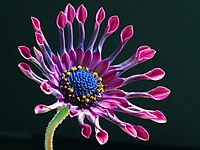
Photo from wikipedia
Abstract The horticultural cultivars of Hemerocallis (daylily) have been used to treat diseases such as insomnia, inflammation and depression, and also as a vegetable in eastern Asia. Taking into consideration… Click to show full abstract
Abstract The horticultural cultivars of Hemerocallis (daylily) have been used to treat diseases such as insomnia, inflammation and depression, and also as a vegetable in eastern Asia. Taking into consideration the fact, that the volatile compounds in Hemerocallis cultivars have not been investigated to date, we decided to study the composition of the essential oils (EOs) from the aerial parts of ten varieties collecting in Poland. EOs, obtained by hydrodistillation, were analyzed by GC/MS method that resulted in identification of 23-36 volatile compounds comprising 89.5%–96.3% of the total amount. The essential oils differed in their composition and they can be classified into three groups. The antibacterial and antioxidant activities of EOs were also evaluated. Gram-negative strains were most strongly inhibited by all tested oils. Two model systems have been used for the antioxidant efficacy, 2,2-diphenyl-1-picryl-hydrazyl (DPPH•) andβ-carotene bleaching assays. The essential oils with the high presence of oxygenated monoterpenes and monoterpene hydrocarbons showed higher antioxidant activity. The chemical composition of EOs of Hemerocallis cultivars and their biological activity is reported for the first time. Thus, the findings presented here suggest that the aerial parts of Hemerocallis cultivars may be candidates for the development of new phytomedicine. Graphical Abstract
Journal Title: Open Chemistry
Year Published: 2019
Link to full text (if available)
Share on Social Media: Sign Up to like & get
recommendations!